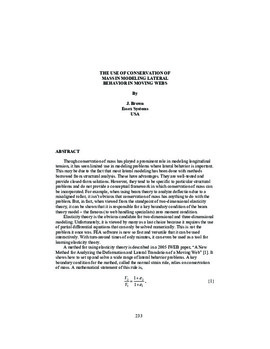| dc.contributor.author | Brown, J. | |
| dc.contributor.other | International Conference on Web Handling (2011) | |
| dc.date.accessioned | 2019-11-11T21:01:20Z | |
| dc.date.available | 2019-11-11T21:01:20Z | |
| dc.date.issued | 2011-06 | |
| dc.identifier | oksd_icwh_2011_brown1 | |
| dc.identifier.citation | Brown, J. (2011, June). The use of conservation of mass in modeling lateral behavior in moving webs. Paper presented at the Eleventh International Conference on Web Handling (IWEB), Stillwater, OK. | |
| dc.identifier.uri | https://hdl.handle.net/11244/321984 | |
| dc.description.abstract | Though conservation of mass has played a prominent role in modeling longitudinal tension, it has seen limited use in modeling problems where lateral behavior is important. This may be due to the fact that most lateral modeling has been done with methods borrowed from structural analysis. These have advantages. They are well-tested and provide closed-form solutions. However, they tend to be specific to particular structural problems and do not provide a conceptual framework in which conservation of mass can be incorporated. For example, when using beam theory to analyze deflection due to a misaligned roller, it isn't obvious that conservation of mass has anything to do with the problem. But, in fact, when viewed from the standpoint of two-dimensional elasticity theory, it can be shown that it is responsible for a key boundary condition of the beam theory model - the famous (to web handling specialists) zero moment condition. | |
| dc.description.abstract | Elasticity theory is the obvious candidate for two-dimensional and three-dimensional modeling. Unfortunately, it is viewed by many as a last choice because it requires the use of partial differential equations that can only be solved numerically. This is not the problem it once was. FEA software is now so fast and versatile that it can be used interactively. With turn-around times of only minutes, it can even be used as a tool for learning elasticity theory. | |
| dc.description.abstract | A method for using elasticity theory is described in a 2005 IWEB paper, "A New Method for Analyzing the Deformation and Lateral Translation of a Moving Web" [1]. It shows how to set up and solve a wide range of lateral behavior problems. A key boundary condition for the method, called the normal strain rule, relies on conservation of mass. | |
| dc.description.abstract | This paper will show that the normal strain rule is a special case of a more comprehensive concept that provides a framework for solving a broader scope of problems than contemplated in 2005, especially those in which the relaxed web is not flat. It will also introduce a computationally efficient method for implementing this concept by treating all webs, flat or otherwise, as membranes in a two-dimensional frame of reference. | |
| dc.description.abstract | To be of practical use to investigators, the concepts discussed here and in the 2005 paper [1] require the use of numerical analysis software to solve the partial differential equations. Adaptation of the mathematics to the requirements of a solver is not a trivial task. Therefore, in the hope of facilitating work by others in this area, I will make available the solver script for a misaligned roller to anyone who requests it. | |
| dc.format | application/pdf | |
| dc.language | en_US | |
| dc.publisher | Oklahoma State University | |
| dc.rights | In the Oklahoma State University Library's institutional repository this paper is made available through the open access principles and the terms of agreement/consent between the author(s) and the publisher. The permission policy on the use, reproduction or distribution of the article falls under fair use for educational, scholarship, and research purposes. Contact Digital Resources and Discovery Services at lib-dls@okstate.edu or 405-744-9161 for further information. | |
| dc.title | Use of conservation of mass in modeling lateral behavior in moving webs | |
| osu.filename | oksd_icwh_2011_brown1.pdf | |
| dc.type.genre | Conference proceedings | |
| dc.type.material | Text | |
